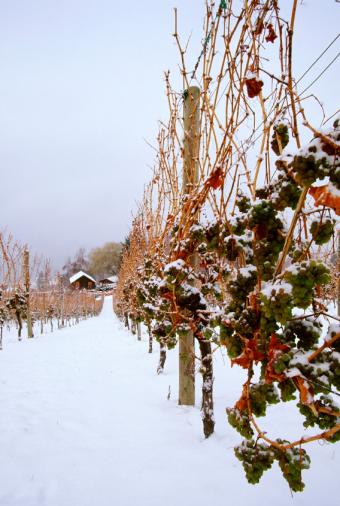
Ice Wine, or the German word "Eiswein," is a magical dessert wine that can only be made in very cold, Northern Hemisphere countries like Canada and Germany. Its origin is often debated, some believing it goes back to 9th century Germany and others sure it was not made until the 12th century in Austria.
Production of Ice Wine
Given a special Prädikat within the QMP (Qualitätswein mit Pradikät) category specific by German law, ice wine is traditionally made by allowing the grapes to stay on the vines considerably longer than normal. This does two things:
- First, the grapes become "late harvest," meaning the sugars in the grapes concentrate - literally, becoming like raisins.
- Second, in the regions where the wine is produced, it means that the grapes stay on the vines until late fall and well into mid or late November when it begins to snow.
Only when the ambient air temperature ranges is around 18°F, are the grapes actually harvested; always by hand and often between 4:00 a.m. and 10:00 a.m. in the morning (by 10:00 a.m., when the sun gets high enough the sky, it gets too warm out). All this is carefully monitored for the sole reason that at this cold temperature, the water crystals within the grapes are frozen solid, leaving the unctuous, sweet liquid juice.
The entire winemaking process occurs at this reduced temperature. The grapes go into a specially-chilled hand pump with care given to assure the water crystal remain in the press while the cold, concentrated juice (known as must), which freezes at a lower temperature than the water, is extracted out for fermentation.
While the sugar levels are elevated (often in excess of 35 or 40 brix), so too are the acid levels. This means that instead of a syrupy, sickly sweet wine, an exceptional ice wine will be balanced and expressive, showing surprisingly fresh, clean flavors of citrus, lychee, minerality, and floral notes.
Ice Wine the World Over
While it is generally agreed that ice wine originated in frozen Northern European climate, by the 1970s North America gained a significant foothold in the industry. Canada's production of this highly-sought wine skyrocketed with the awarding of the Grand Prix trophy in Bordeaux in June 1991 given for the 1989 Inniskillin Vidal Icewine. Canada's production is now in excess of 250,000 bottles a year. The Finger Lakes region of New York entered the ice wine race as late as the 1990s and is already gaining a respect.
Fake Ice Wine
There are a handful of southern states producing what can only be considered "fake" ice wines. Because the temperatures in California or Washington never get low enough to properly freeze the grapes, there are a few known producers who pick the grapes early in the morning, freeze them, and continue the winemaking process as though it happened naturally. Technically they shouldn't call their wines "ice wine" and some countries have passed laws that its production follow VQA (Vintners Quality Alliance) regulations. As with many international labeling laws, America is the last to follow suit and does not yet recognize the legislation. You might see these wines called "Vin de Glace". The production of fake ice wines is actually happening all over the globe so it is best to purchase from reputed producers.
These luxurious dessert wines can be made from a wide variety of grapes. In Europe, ice wine is usually produced from Riesling, Ehrenfelser, and Gewurztraminer while Canada's production is focused on Vidal Blanc, Cabernet Franc, Seyval Blanc, and Merlot. There are even sparkling ice wines being made.
Ice Wine Pairings
Considered a dessert wine and being intensely sweet, you would not want to drink an ice wine with an overly sweet dessert like crème brulée or chocolate cake. Serve it in small liqueur glasses with a few bites of cheese (blue and goat cheeses are exceptional) for dessert, but don't discount pairing this delightful wine with a foie gras course before a main entrée.







